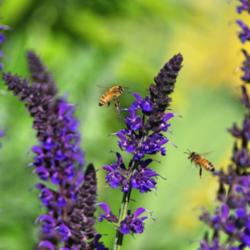Native to the Mediterranean. Loves sunshine and warmth, although some cold hardy strains (Arp, to zone 6) have been cultivated. Quite xeric.

I plant this every year because it is a hummingbird magnet. They prefer it over the nectar in the feeder. It's such a gorgeous plant. In our zone it does slightly better in a little light shade: The plants seem to grow larger and flower more heavily. It keeps producing flowers until frost, which is a great advantage in the late season garden.

Sage (Salvia x sylvestris) 'Mainacht' is one of my all-time favorite sages. The blue-lavender blossoms begin blooming in my Maryland garden in May and continue until first frost in October. It is a sizable Salvia, reaching to two feet high with about an 18 inch spread. Like other Salvias, it has aromatic leaves and does well in medium to dry soil in full sun. It is a pollinator magnet from first bloom in May to last bloom in October, attracting both butterflies and bees.

My favorite plant in my garden, it blooms almost non-stop here in zone 8 from spring till frost, the blooms cover every bit of it, and it attracts the hummers like crazy. Anywhere I take this plant with me, I'm sure to make some winged friends. I've tried providing them with other hummer-friendly plants, but they always prefer Hot Lips. A small start will quickly grow into a large shrub in two seasons. I think everyone should grow this plant!

Leaves fragrant, used to make tea or jelly. Edible flowers attract bees & butterflies.

I've had this for years. It's a lovely coral color. They self sow, and they grow easily, although they sprout a bit later than you might expect. Once blooming, they go nonstop until frost.

"Salvia coccinea (Texas sage, scarlet sage, tropical sage, blood sage) is a herbaceous perennial in the Lamiaceae family that is widespread throughout the Southeastern United States, Mexico, Central America, the Caribbean, and northern South America (Colombia, Peru, and Brazil). At one time Brazil was considered to be where it originated, but its diploid chromosome count now points to Mexico as its place of origin.

Sage (Salvia sylvestris) 'Caradonna' produces lavender blue flower stalks from late spring to early fall. It does well in medium to dry soil in full sun. In my zone 7a garden, it was a pollinator magnet in the late spring and early summer when nectar sources were still limited, attracting both bees and butterflies. 'Caradonna' is a smaller cultivar than 'May Night', reaching less than 2 feet tall, but it has a similarly long bloom period given the right garden conditions.

Salvia azurea is a lovely, easy-to-grow plant here. It blooms in late summer and fall with long wispy stems topped with sky blue flowers. The hummingbirds and butterflies use this plant some, but it's more of a bee plant. It's been very drought tolerant and has survived severe drought and watering bans.

I have raised this lovely plant on and off for years. In my borderline zone 7b/8a, it acts as a half-hardy perennial, lasting for a few years (not more than three seasons), until a colder than normal winter takes it out for good. I then replace them.
